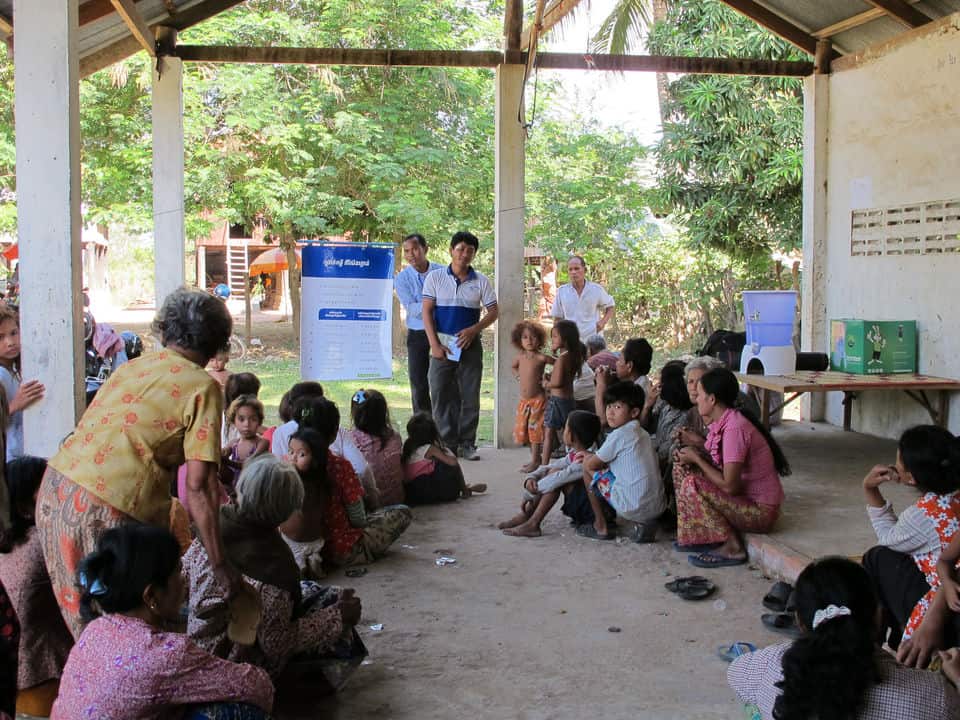Hydrologic Social Enterprise won an Ashden Award in 2012 for its work protecting people’s health, and Cambodia’s forests, through the manufacture, sale and distribution of affordable ceramic water filters to customers in rural Cambodia.
Why Social Enterprise?
Hydrologic’s roots go back to a safe water programme initiated in 2001 by the international NGO, iDE. In 2009 iDE received technical and financial support to facilitate the transition to for-profit enterprise.
Formally registered in 2010, Hydrologic expanded its production capacity, established a rural sales force, partnered with a microfinance institution, and became certified to generate and sell carbon credits. Hydrologic became profitable in 2012 and has remained so each year since.
Factors affecting the decision to become a social enterprise included the scale and complexity of the production and distribution, the generally low level of development in the existing ceramics industry, the importance of quality control for a health-related product, and the lack of a strong regulatory environment to protect consumer interests.
The social enterprise approach was deemed the most practical option for achieving sustainability while maintaining positive social impact.
9 Lessons Learned
- Public funds for social enterprise. Donor funding is justifiable for social enterprise models in challenging markets. Over 14-years US$2.5m in grants were invested in Hydrologic’s development and the financial return to rural Cambodians has reached approximately US$89m.
- Allow time to make mistakes. Social business incubation requires a reasonable time horizon and a learning orientation. In the beginning, iDE aimed for commercial sustainability for the filter programme but did not know the exact pathway to get there. Time and flexibility were needed to allow for mistakes to be made and corrected.
- Avoid start-stop funding. It was difficult to secure consistent funding during start up. From 2001-2008, the filter programme was funded by small, short-term grants. The start-stop nature of the funding kept the staff in survival mode and made it difficult to build momentum and focus.
- Avoid relying on NGO sales. Pros: bulk sales cost less to make, NGOs can supply filters to those who could not otherwise afford one; bulk sales increase production scale and profitability. Cons: giveaways can undermine markets and cannibalize future sales; users who receive a free filter are less likely to use it properly; NGO sales are irregular and hard to plan for.
- Focus on face-to-face marketing. A number of mass media campaigns were implemented over the years including radio and TV spots, but no strong correlation was noted between media spend and sales results. Hydrologic shifted its marketing effort toward group meetings and door-to-door sales. The personal connection is better at building customer trust and the link with sales results is clearer.
- Understand the customer. People with low incomes like beautiful things too. They understand the health benefit but it does not move them to action. Prestige and convenience are better triggers because they connect at an emotional level. This applies not only to products but also to promotional messages, finance models, and after-sale service.
- Professionalise sales. Selling is a hard job. Sales agents need to keep a positive attitude in the face of frequent rejection. Hydrologic worked with Whitten & Roy Partnership to craft tools and methods for making sales, monitoring progress, noticing problems early, and responding with solutions.
- Credit is king. Customer access to micro-credits is key to the success of sales. In one region where cash sales were attempted first, the addition of credit resulted in four times more sales. But be warned, once sales agents start selling on credit it is hard to motivate them to go back to selling on cash.
- Get ready for a rollercoaster ride. Nurturing a social enterprise from start-up to maturity requires commitment and tenacity. The enterprise stood on the verge of failure numerous times. Crisis events included cash flow pinches, a grant cancellation, an asset ownership dispute, personnel conflicts, and a year-long delay in the carbon finance application.

